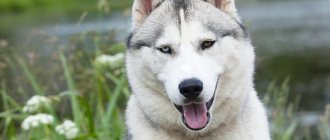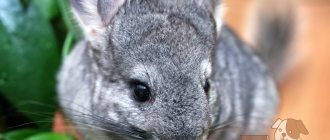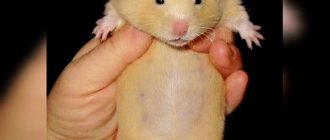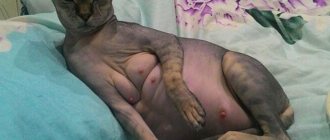Reproduction of rabbits is not a complicated process and rarely occurs with complications. But sometimes human intervention is required so that the rabbit’s birth ends safely and the animals remain healthy. In order to competently help in case of problems with litter and properly prepare the female for childbirth, the rabbit breeder needs to know the basics of animal physiology.
How to determine if a rabbit is pregnant
After the female has been in the male’s cage and effective mating has occurred (the male falls on his side with a loud squeak at the end of the mating), pregnancy can be expected.
Pregnancy in rabbits is difficult to determine in the early stages. The female's belly increases slightly; she cannot be distinguished from a single female by external signs.
Only in the second half of pregnancy - after the 15th day - can an experienced rabbit breeder palpate the fruits through the abdominal wall of the female rabbit.
How to do it at home:
- The female is seated on a flat surface so that she does not try to escape and sits quietly.
- A hand is placed on her lower abdomen and the cubs are carefully felt.
- The fruits at this stage look like large soft walnuts.
They probe the rabbit very carefully, trying not to damage the babies. If the female is not tame, is tense and breaks out of her hands, this method is not suitable.
Other signs of pregnancy:
- change in behavior (the female becomes more irritable);
- increased appetite;
- in the second half of the term, you can notice the roundness of the forms and the sluggishness of the animal;
- In the last days before childbirth, swelling of the mammary glands is observed.
An effective method for determining pregnancy is the male test . 8–10 days after the first mating, the female is re-placed with the rabbit and her behavior is observed. If the female rabbit runs away from the male, squeaks subtly and even tries to bite him, she can be considered pregnant.
Preparing for the birth of offspring
After sexual intercourse, place the female in a spacious cage - throughout pregnancy and after lambing she should be kept separate from the rabbits. The male is able to fertilize the animal immediately after the previous birth, the female rabbit will become stressed and will not be able to feed the offspring that have already appeared. Some experienced farmers advise placing the female close to the male, but in different cages. To allow animals to communicate, place them nearby.
The pregnant rabbit is separated from the male, but not far away, so that the animals can communicate
If the room is hot, provide fresh air, but avoid drafts. If the pregnancy is delayed, it may be false or the offspring died in the rabbit’s body. Be sure to keep the veterinarian’s phone number nearby - if problems arise during pregnancy, lambing or after it, you can enlist the support of a specialist.
Rabbit cages
Preparing a nest for a pregnant rabbit
As soon as you have established that the female is pregnant, three to four days before the planned lambing, place a cardboard box or box in the cage - there she will build a nest for future babies
It is important to guess with time - if you put the box in too early, it will be used instead of the toilet
| Photo | Description |
| Step 1 | Pick up an unnecessary box or an old box in which the rabbit will build a nest. Choose a box that is larger in size than the female. |
| Step 2 | Make a hole in the box so that the expectant mother can easily get in and out of it. Carefully wash, clean and disinfect the future nest with hot water and a solution of potassium permanganate. |
| Step 3 | Place the box in the pen or cage where the pregnant female lives. Place a newspaper inside, add soft hay there, distribute some hay around the cage - the expectant mother herself will begin to further arrange the nest. |
Box, drawer as a nest for rabbits
The birth process: how do female rabbits give birth?
Baby rabbits are born very easily. The female sits comfortably in her nest and begins preparing for lambing. The mother rabbit sits in such a way that after the babies are born she can immediately lick them. When the baby rabbits emerge from the birth canal, they are located between the hind legs of the female. Blind and hairless, they appear with their hind legs first. When all the rabbits are born, the female rabbit swallows the afterbirth and begins to lick the newborns. The farmer's help is not needed during lambing - the female will do everything on her own.
Newborn rabbits
Do not touch newborn rabbits unless necessary - you will leave your scent on them, and the mother will be able to eat her babies. If the baby rabbit falls out of the nest, return it back after wearing protective gloves. When babies' eyes open (around 10 days of age), check the animals for infections and unopened eyes. By the age of eight weeks, the rabbits are separated from the female, otherwise she may begin to get rid of them on her own.
| Period | Baby rabbit weight |
| At birth | 40-80 grams |
| A few days after birth | 50-100 grams |
| On the sixth day | 80-160 grams |
Monitor the number of stillborns. A few hours after giving birth, distract the female with a treat and check the litter. If there are dead ones, immediately take them from the nest and make sure that the rest are alive and moving. If a female has given birth to many rabbits, move several of them into the cage of another female rabbit who has recently given birth. Place the baby rabbit under the animal's fur and it will take on the responsibility of raising the offspring.
Offspring of rabbits
The birth of a new rabbit offspring is an exciting and joyful event in the life of every livestock breeder. Take good care of the females, feed the animal properly during pregnancy, help it arrange its nest, and it will thank you with strong and healthy rabbits.
How many rabbits does a mother rabbit bear?
A rabbit's pregnancy lasts from 28 to 35 days, with the average being 30–31 days. The following factors influence the timing of pregnancy:
- The age of the female - the first-born often move around.
- Number of heads in the litter - multiple pregnancies are shorter.
- Conditions of feeding and maintenance. In rare cases, when the female feels a threat to her offspring, she may delay the birth of her rabbits for several days.
The duration of gestation is influenced even by the noise level near the animal’s cage. Unexpected loud noises can trigger accelerated labor.
What you need to know about okrol
- It is necessary to know with probable accuracy when to expect childbirth. This will allow timely assistance if the rabbit has problems.
- Childbirth usually occurs in the morning. This process cannot be called long, but sometimes it can drag on for a day or even two
- Rabbits can be born head-first or feet-first
Most often, there is no need to help a rabbit with childbirth. The main thing is to provide an appropriate environment, which consists of creating silence and eliminating factors that can cause stress in the animal (noise, excess light, loud sounds, strangers and animals).
After birth, you need to check whether everything went well: whether all the babies were born healthy, breathing calmly and drinking mother's milk. Typically, a female rabbit can produce up to 12 offspring at a time. At this time, the female must have plenty of fresh water, otherwise she will destroy the litter.
It is believed that rabbit farming is not a very simple type of farming, which has a number of its own nuances. And bearing offspring is a very important aspect. In fact, there is nothing complicated about it, and it is also exciting and profitable! The main thing is that during the period when the rabbit is pregnant, follow the rules for caring for her. Then the offspring will be born healthy and strong, to the delight of the breeder.
How many cubs can be born in one litter?
The number of heads in a litter depends on the breed, age and level of feeding of the animals. One litter of rabbits can bring a rabbit breeder from 5 to 14 rabbits. Most often, 8–11 babies are born.
In multiple births (more than 12 heads), as a rule, the offspring are smaller in size and weaker. The female may not have enough of her own milk to feed all the cubs. Many rabbit breeders remove extra babies from the nest immediately after birth, leaving no more than 8. The removed rabbits are placed with low-fertile females or fed artificially.
conclusions
- How long a rabbit bears baby rabbits is influenced by several factors: the breed, the number of babies, and whether the female gives birth for the first time or not.
- Pregnancy is a very important period that requires attention and increased care from the farmer.
- Pregnancy is determined no earlier than 10-14 days.
- During pregnancy and immediately after giving birth, the female requires a special diet and a lot of water.
- Usually the female rabbit does not need assistance during childbirth, but the process should still be monitored in case she still cannot give birth on her own.
- If the rabbit does not become pregnant, then the reasons should be sought in improper care, feeding or mating conditions.
Care and nutrition during pregnancy
A pregnant rabbit should receive nutritious food rich in vitamins. An approximate diet of an animal looks like this:
- legume or legume-cereal hay (withered grass in summer) - ad libitum;
- feed for rabbits or grain mixture (oats, barley, corn) - 100–250 g;
- fresh vegetables (carrots, pumpkin) - 100–150 g;
- chalk or crushed eggshells - 2 g;
- table salt - 1.5 g.
Compared to the diet of single animals, a pregnant rabbit should receive 30–50% more feed.
If a grain mixture is used in feeding, and not a complete feed, complex vitamins - Chiktonik, Tetrahydrovit, Vittri - must be added to the water.
Pregnant females are provided with peace, protected from loud noises, heat and cold. If animals are kept in cages outside, they are protected from sunlight and wind.
For rabbits, extreme heat is more dangerous than cold. If the air temperature rises above +27 degrees, the animal may die. To alleviate the condition of pregnant females, plastic bottles with frozen water are placed in the cage and covered with damp sheets.
A week before the expected breeding date, a box (nest) is placed in the cage where the female will breed. The bottom of the box is covered with soft hay or soft straw; sawdust is not used because of its pungent odor and the danger of small particles getting into the mouth and nose of the rabbits. Many farmers make special houses for mother rabbits with cubs. In such a dwelling there is a separate “room” where the female makes a nest.
False pregnancy in a rabbit
Due to hormonal imbalance, rabbits sometimes experience false pregnancies. It proceeds almost the same as normal, but the female begins to build a nest (carrying hay into the house and tearing fluff out of her belly) not 22–25 days after mating, but after 2 weeks.
False pregnancy is often accompanied by aggressive and inappropriate behavior of the rabbit. The animal bites, gnaws the walls of the family home, and can inflict wounds on itself.
Individuals in whom false pregnancy occurs a second time are discarded. The cause of an imaginary pregnancy may be the low quality of the male's seminal fluid or frequent childbirth in the female.
How to deliver a baby
The birth of rabbits during the normal course of pregnancy and litter does not require human intervention. A young, inexperienced female may need the owner’s help in the following cases:
- the female rabbit gave birth to her babies in a cage, not in a nest;
- there are stillborn individuals in the litter;
- The female has pulled out little fluff; it is not enough to cover the entire brood.
The actions of the rabbit breeder after the end of the animal's birth are aimed at inspecting the nest and returning the rabbits to their place if they were born outside the cage. A female rabbit, having given birth outside the nest, never brings her babies into the house. Rabbits generally do not carry their offspring in their teeth, like cats, nor do they cover them with down. On the floor of the cage, the cubs will quickly freeze and die.
The baby rabbits are collected and placed in the nest, covered with down. If necessary, more fluff is plucked from the rabbit to cover the babies. Dead babies are removed from the nest.
When manipulating the nest and offspring, the owner’s hands should not smell of cream, perfume, or aromatic soap. Foreign odors can cause the female rabbit to leave the nest and not come to feed the children.
It is necessary to monitor the presence of clean water in the mother's cage . A female rabbit who is thirsty and unable to satisfy it can eat her offspring.
Gestation period
Now we should talk about how long pregnancy lasts in rabbits and how it proceeds. Most often, the period is one month, plus or minus three or four days. Anything longer or shorter in duration is already a pathology and does not bring any serious benefit, but does more harm. A month with a backlash of a couple of days - no more.
Births by number
Young mothers who have relatively small litters (from two to four rabbits) - their gestation period usually lasts longer. Whereas numerous offspring come out earlier. There is clearly an inverse relationship here.
Of course, when a small number of rabbits are born, they emerge larger and more well-developed. And abundant offspring can rarely boast of the same indicators. The ideal is considered to be the notorious “golden mean” of how many rabbits this female rabbit bears, between the above two points, with a periodic bias toward small numbers for breeding individuals.
Stress during childbirth
The pregnancy period in rabbits is a rather stressful phenomenon in itself, especially for young rabbits. Therefore, they must be reliably protected from all types of stress while it lasts. The following points fall under this category:
- flashes of light;
- sharp sounds;
- shouts;
- unexpected touches;
- frequent transfers from place to place.
The problem is that rabbits are very timid animals. In the wild, they save themselves only with this, and also with their fast legs. In a cage they have nowhere to run, so there is a high chance of, if not heart rupture, then at least miscarriage, for pregnant females. Therefore, during the pregnancy of each rabbit, while she is carrying babies, she should be treated accordingly.
Arrangement of the queen cell
To avoid this, you should not only protect them from stress. It is necessary to ensure the presence of a shelter, which will later become a nest. We are talking about queen cells. These simple structures are assembled from wooden boxes or plywood. Almost anyone can cope with this task even with their own hands.
The main thing is that the inside is well sanded, the walls are opaque, and the entrance is round, like a hole, and at some elevation
The latter is required as a precaution so that small rabbits cannot get out of the nest ahead of time. Considering how these little fidgets behave, this is possible
In addition, the queen cell must have warm and dense litter. You can lay it out a couple of days before the birth, after which it should not be touched until the baby rabbits leave the nest. Now everything is ready for the birth.
What to feed a female rabbit after giving birth
For a couple of days after birth, the animal’s diet remains unchanged. Then the rate of grain and succulent feed is gradually increased, bringing it to 300 g and 600 g per day, respectively.
The lactating female is fed three times a day, giving preference to nutritious foods: oats, barley, corn, legume hay (alfalfa, sainfoin). To increase lactation (milk production), succulent food is given: carrots, fodder or sugar beets, zucchini, pumpkin.











